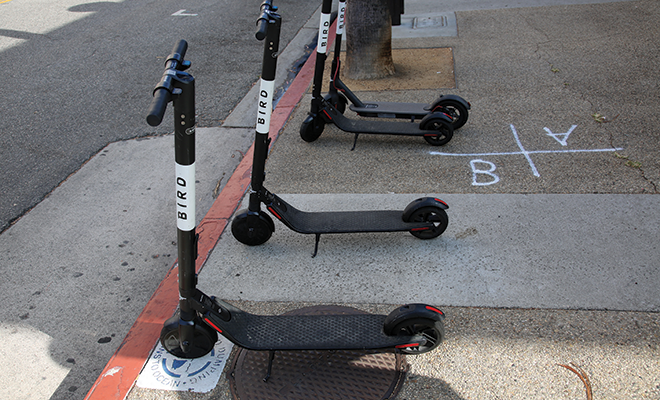
The Saga of Electric Scooter-Sharing
They’re calling it “micro-mobility,” the electric scooter-sharing programs that popped up unannounced and without permission in some cities across America in 2017 and 2018. Touting themselves as purveyors of clean and convenient transportation, companies such as Bird, Lime and Skip offer riders an easy way to get around urban areas, but at what cost?
It’s called micro-mobility, and it has its roots in the bike-sharing movement that grew legs in the mid-’90s and hit its stride in the early 2010s with companies such as Citi Bike and DecoBike. Setting up “docks,” essentially bike racks with automated kiosks, riders could slide their cards, choose their length of use and get a code to unlock a bike that they could return to any of the many other docks throughout the city.
Eventually, these evolved into dockless bike-shares and then dockless electric scooter-shares, with which riders use an app to locate and rent scooters. With no centralized docking system, riders can simply leave their scooters anywhere they please when they’ve completed a ride.
It seemed like the perfect setup. The whole process requires no people and no planning. Scooters are arguably easier to ride than bikes; they’re smaller and less aerobic, making them a good sweat-free option for commuters, but these programs have been steeped in controversy from the get-go.
What’s the problem?
It all started when Bird “nests,” groups of scooters, seemed to show up overnight in cities across the country. Bird didn’t tell anyone they were coming. No, their RSVP didn’t get lost in the mail, it was all part of the plan; the company’s CEO is reported as having said the company reaches out to city regulators at the same time as launch, not before.
With no proper planning, city regulators have been left scrambling to determine where exactly electric scooters belong. Topping out at speeds of 15 to 20 mph, scooters are too slow for traffic and too fast for sidewalks, leaving them in no-man’s-land with no suitable riding location save for bike lanes, which are scarce enough as it is.
This “ask forgiveness, not permission” approach to business comes at the cost of safety. Several riders have been killed in scooter-related incidents pertaining both to loss of control and car strikes. Blogs and message boards are littered with stories from posters who’ve gotten hit by scooters while enjoying bike and pedestrian paths. Many have had to pull children from the paths of practically silent oncoming scooters.
With Bird now in more than 100 cities on three continents, it’s alarming that, when unlocking a scooter, there is little information in the app on how to operate the vehicle. Bird’s operational instructions listed online are only 25 words long.
Still, we can’t look past riders’ share of the blame. Most companies’ user agreements require riders to be at least 18 years of age and have a valid driver’s license, but parents still rent them for their kids; younger teens rent them for themselves. Bird also requires users to park their scooters in “lawful parking spots,” yet electric scooters are littering city sidewalks, blocking pedestrian traffic. People with disabilities have reported impeded use of the sidewalk routes they require to get to work and home again. Some have even had trouble gaining entry to buildings because of scooters left on ADA-accessible ramps.
What’s being done?
Some city dwellers are at wit’s end. In Los Angeles, frustrated residents have set scooters on fire, thrown them into the ocean or systematically dismantled them entirely. Some have even snipped brake cables, causing potential for great harm to users; the scooters will still operate without functioning brakes.
Lawmakers aren’t taking the concern lightly. Some cities have banned them temporarily, but few seem interested in ruling them out altogether. Many cities are working with micro-mobility companies to establish pilot programs to ensure safer use of the scooters, placing hope in geofencing capabilities to zone cities for electric scooter use. Geofencing would alert riders when they are entering no-ride and no-park zones. Some companies are even working on technology that would deactivate a scooter that crosses into a no-zone or, even more precisely, deviates from a bike lane onto a sidewalk.
Some consider the issues with micro-mobility the growing pains of a new, eco-friendly transportation system, but one can’t help wondering if lives could have been spared had the scooter-sharing companies worked with cities prior to launch instead of leaving lawmakers to put the genie back in the bottle. Even if these problems are resolved, we are left with the tough questions of safety and the companies’ direction. We’ll be watching this topic in the future. ■
Sources: bird.co, latimes.com, sacbee.com and govtech.com.







